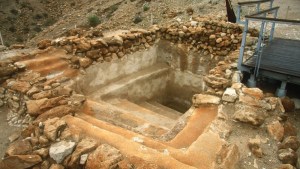The Levantine Iron Age (1200-500 B.C) is a historical period of particularly foggy chronology. A deeply transformative era, it began with the decline of Bronze Age societies throughout the Eastern Mediterranean, and concluded with the collapse of Babylonian imperial rule at the end of the 6th century BC. As Fred Schwaller explains in his article for DW, this was a time “when many of the cultural histories of the Near East, North Africa and Europe were created, passed on through stories originally from the Hebrew Bible.”
Schwaller’s article reminds the reader how “matching events in the holy texts with actual history is a contentious issue among researchers.” They even have a name for it: It’s “the Iron Age Chronology Debate,” an ongoing discussion-conversation about the chronology of the events in the Bible during the Levantine Iron Age.
That debate might now be entering a new stage. Yoav Vaknin, an archeologist at Tel Aviv University and the Hebrew University of Jerusalem, recently published a paper in which he explains how a new method called geomagnetic and/or archaeomagnetic dating can help discover when events during the Levantine Iron Age took place.
Using these methods, archaeologists can now combine the biblical text’s account, extrabiblical historical sources, and scientifically excavated artifacts to arrive at a more precise dating of some events described in the Bible. Vaknin’s study, for example, focuses on military campaigns, including Pharaoh Shoshenq I’s conquest of the Levant around 900 BC, precisely at the peak of the Levantine Iron Age.
As Amanda Borschel-Dan explains in her article for The Times of Israel, “the method utilizes excavation layers that have already been reliably dated to create baseline anchors for the archaeomagnetic data, which can then be applied to other sites that until now had been impossible to confidently date. The more anchors are created, the researchers say, the more finely calibrated the dating method will become.”
Vaknin’s study, titled “Reconstructing biblical military campaigns using geomagnetic field data,” was published Tuesday in the open-sourced scientific journal Proceedings of the National Academy of Sciences of the USA (PNAS). It tried out the method on 20 excavation layers, some of which could not previously be securely dated.
In short, the magnetic field is a constantly shifting invisible “shield” that stems from magnetic ore in the Earth’s core. Archaeological findings such as pottery sherds, bricks, roof tiles, and furnaces record the Earth’s magnetic field as they are burned at high temperatures, causing their magnetic minerals to be re-magnetized to the direction and magnitude of the field when they were heated. This data, Vaknin’s study explains, is similar to a fingerprint and is unique to the date it was recorded.



